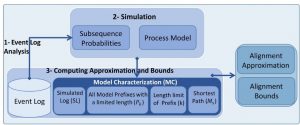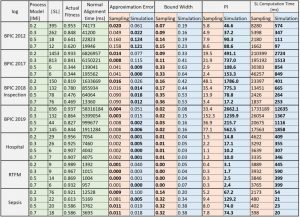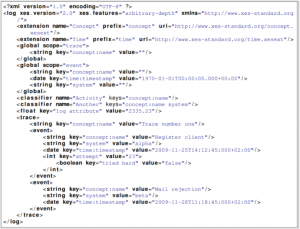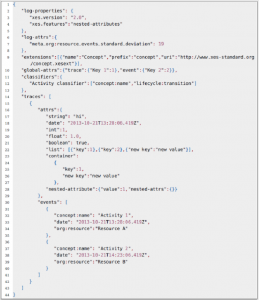Archive for November, 2020
Conformance Checking Approximation Using Simulation
This post is by Mohammadreza Fani Sani, Scientific Assistant in the Process and Data Science team at RWTH Aachen. Contact her via email for further inquiries
Conformance checking techniques are used to detect deviations and to measure how accurate a process model is. Alignments were developed with the concrete goal to describe and quantify deviations in a non-ambiguous manner. Computing alignments has rapidly turned into the de facto standard conformance checking technique.
However, alignment computations may be time-consuming for real large event data. In some scenarios, the diagnostic information that is produced by alignments is not required and we simply need an objective measure of model quality to compare process models, i.e., the alignment value. Moreover, in many applications, it is required to compute alignment values several times.
As normal alignment methods take a considerable time for large real event data, analyzing many candidate process models is impractical. Therefore, by decreasing the alignment computation time, it is possible to consider more candidate process models in a limited time. Thus, by having an approximated conformance value, we can find a suitable process model faster.
By providing bounds, we guarantee that the accurate alignment value does not exceed a range of values, and, consequently we determine if it is required to do further analysis or not, which saves a considerable amount of time. Thus, in many applications, it is valuable to have a quick approximated conformance value and it is excellent worth to let users adjust the level of approximation.
In this research, we extend the previous work by proposing to use process model simulation (i.e., some of its possible executable behaviors) to create a subset of process model behaviors. The core idea of this paper is to have simulated behaviors close to the recorded behaviors in the event log. Moreover, we provide bounds for the actual conformance value.
Fig 1. A schematic view of the proposed method.

Using the proposed method, users can adjust the amount of process model behaviors considered in the approximation, which affects the computation time and the accuracy of alignment values and their bounds. As the proposed method just uses the simulated behaviors for conformance approximation, it is independent of any process model notation.
Table 1. Comparison of approximating the conformance checking using the proposed simulation method and the sampling method.

Since we use the edit distance function and do not compute any alignment, even if there is no reference process model and just some of the correct behaviors of the process (e.g., some of the valid variants) are known, the proposed method can approximate the conformance value. The method additionally returns problematic activities, based on their deviation rates.
We implemented the proposed method using both the ProM and RapidProM platforms. Moreover, we applied it to several large real event data and process models. We also compared our approach with the state-of-the-art alignment approximation method. The results show that the proposed simulation method improves the performance of the conformance checking process while providing approximations close to the actual values.
If you are interested in this research, please read the full paper at the following link: https://ieeexplore.ieee.org/document/9230162
If you need more information please contact me via fanisani@pads.rwth-aachen.de
JXES – JSON support for XES Event Logs
This post is by Madhavi Shankara Narayana, Software Engineer in the Process and Data Science team at RWTH Aachen. Contact her via email for further inquiries.
Process mining assumes the existence of an event log where each event refers to a case, an activity, and a point in time. XES is an XML based IEEE approved standard format for event logs supported by most of the process mining tools. JSON (JavaScript Object Notation), a lightweight data-interchange format has gained popularity over the last decade. Hence, we present JXES, the JSON standard for the event logs.
JXES Format
JSON is an open standard lightweight file format commonly used for data interchange. It uses human-readable text to store and transmit data objects.
For defining the JSON standard format, we have taken into account the XES meta-model represented by the basic structure (log, trace and event), Attributes, Nested Attributes, Global Attributes, Event classifiers and Extensions as shown in Figure 1.

The JXES event log structure is as shown in Figure 2.

The plugin for ProM to import and export the JSON file consists of 4 different parser implementations of import as well as export. Plugin implementations are available for Jackson, Jsoninter, GSON and simple JSON parsers.
We hope that the JXES standard defined by this paper will be helpful and serve as a guideline for generating event logs in JSON format. We also hope that the JXES standard defined in this paper will be useful for many tools like Disco, Celonis, PM4Py, etc., to enable support for JSON event logs.
For detailed information on the JXES format, please refer to https://arxiv.org/abs/2009.06363

